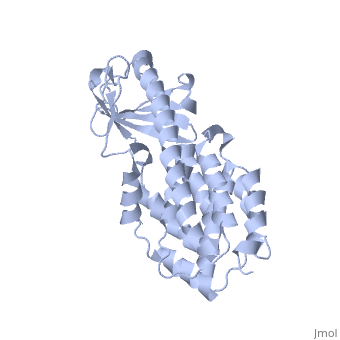Colicin N
From Proteopedia
Colicin N is a type of Colicin, a bacteriocin made by E. coli which acts against other nearby E. coli to kill them by forming a pore in the membrane, leading to depolarisation of the membrane which kills the cell. This structure shows both the receptor binding and pore forming domains.
Synthesis and releaseThe plasmid encoding the c. 42kDa[1] ColN also encodes its corresponding Colicin Immunity Protein, Cni, in order to protect the colicinergic cell from the cytotoxic activity of the colicin. Two types of ColN plasmid have been discovered[2]. Mechanism of uptakeColicin N parasitizes the outer membrane protein F (OmpF) as both its receptor and its translocator[3], alongside the Tol proteins TolQRA. There is evidence to show that the translocation may occur at the protein-lipid interface. The receptor binding domain contains a six-stranded antiparallel β sheet wrapped around the N-terminal α helix of the pore-forming domain[4]. ColN binding displaces OmpF-bound lipopolysaccharide, the major lipid in the outer leaflet of the outer membrane. The N terminal region of ColN then rearranges and binds to OmpF[5]. As only OmpF is required, this may reveal how a general translocation route for a number of colicins may function[6]. However there is no evidence that this simply forms a pore for translocation, more work is needed to establish the translocation mechanism[7]. The primary reason for continuing to look for another mechanism is that the diameter of the pore formed by OmpF is not large enough to translocate even an unfolded colicin molecule[8]. The model currently defined has the translocation domain inserting itself into the porin pore. The receptor binding domain remains outside the targeted cell and the pore-forming domain translocates along the outer wall of the trimeric porin channel[9]. Killing ActivitiesColicin N depolarises the E. coli membrane with its Pore Formation activity, leading to lysis of the cell, and the cytotoxic domain that initiates this reaction is highly homologous to the C-terminal domain of ColA[10]. The pore-forming domain structure is a ten α helix bundle also observed in Colicin A, Colicin Ia and Colicin E1. References
| ||||||||||||

